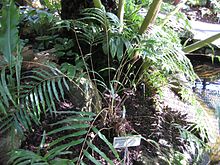| Plenasium banksiifolium | |
|---|---|

| |
| Plenasium banksiifolium | |
| Scientific classification | |
| Kingdom: | Plantae |
| Clade: | Tracheophytes |
| Division: | Polypodiophyta |
| Class: | Polypodiopsida |
| Order: | Osmundales |
| Family: | Osmundaceae |
| Genus: | Plenasium |
| Species: | P. banksiifolium |
| Binomial name | |
| Plenasium banksiifolium (C.Presl) C.Presl | |
| Synonyms | |
| |
Plenasium banksiifolium is a fern in the family Osmundaceae. The genus Plenasium is recognized in the Pteridophyte Phylogeny Group classification of 2016 (PPG I); however, some sources place all Plenasium species in a more broadly defined Osmunda, treating this species as Osmunda banksiifolia. It is native along the Pacific coast of Asia, being found in the Kamchatka Peninsula, the Ryukyu Islands, Japan, southeast China, Taiwan, the Philippines, Borneo, Sulawesi and Java. P. banksiifolium, which can reach a height of 1.5 m, is the largest species in the genus and has ornamental value.
Description
The appearance of the fertile pinnae are very different from that of the sterile pinnae, the fertile pinnae are curled. The sporangia can also grow on the vegetative pinnae immediately above and below the fertile pinnae, with a compact shape; so we might say that P. banksiifolium has three types of pinnae: fertile, sterile, and semi-fertile. The young opening sterile pinnae are red, the fertile pinnae are mustard yellow at first, then turn green and finally reddish brown. The fertile pinnae can reach more than ten pairs.
-
 Sporophylls and vegetative pinnae
Sporophylls and vegetative pinnae
-
 The sporangia on the vegetative pinnae
The sporangia on the vegetative pinnae
-
 Young frond
Young frond
-
 Young frond
Young frond
-
 Vegetative pinnae
Vegetative pinnae
-
 Veinlets forked
Veinlets forked
-
 Rhizome
Rhizome
-
 Plant
Plant
References
- ^ Hassler, Michael & Schmitt, Bernd (August 2019), "Plenasium banksiifolium", Checklist of Ferns and Lycophytes of the World, Version 8.10, retrieved 2019-10-02
- PPG I (2016), "A community-derived classification for extant lycophytes and ferns", Journal of Systematics and Evolution, 54 (6): 563–603, doi:10.1111/jse.12229, S2CID 39980610
- ^ "Osmunda banksiifolia Ching", Plants of the World Online, Royal Botanic Gardens, Kew, retrieved 2019-10-02
- "粗齿紫萁" (in Chinese). iPlant.cn, Flora Reipublicae Popularis Sinicae.
| Taxon identifiers | |
|---|---|
| Plenasium banksiifolium | |
| Osmunda banksiifolia | |
| Nephrodium banksiifolium | |
This Polypodiidae-related article is a stub. You can help Misplaced Pages by expanding it. |